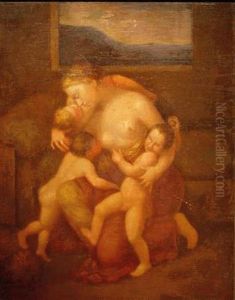F. Cipriani Paintings
Francesco Cipriani, also known as Giovanni Battista Cipriani, was an Italian painter and engraver, born in 1727 in Pistoia, Tuscany. He was part of the movement that later came to be defined as Neoclassicism, with his works reflecting the transition from the ornate Rococo style to the more restrained classical approach that gained prominence towards the end of the 18th century.
Cipriani received his initial training in Florence, showing early promise in the arts. He moved to Rome to further his studies, where he was influenced by the discoveries of ancient art and architecture that were being unearthed at the time. This exposure to the classical past deeply affected his style and thematic choices.
In 1755, Cipriani moved to London, where he was to spend the majority of his career. His move coincided with a period in which the British capital was becoming increasingly receptive to classical art, largely due to the burgeoning influence of the Grand Tour—a cultural expedition across Europe that many young British aristocrats undertook. Cipriani quickly established himself as a sought-after artist for the British elite.
While in London, Cipriani became a founding member of the Royal Academy of Arts in 1768, contributing to the development of the arts in Britain. His work was versatile, ranging from decorative frescoes to book illustrations. He was particularly known for his elegant drawings, which often served as designs for decorative arts, including furniture, silverware, and architectural features. His illustrations were engraved by others and widely circulated, which helped spread his reputation and the neoclassical aesthetic.
Cipriani's influence extended beyond his own works. He was a teacher to several artists who would go on to become significant figures in their own right, such as Thomas Banks, a noted sculptor. Through his teaching and his art, Cipriani played a key role in shaping the taste of his time, promoting a sense of elegance and simplicity that reflected classical ideals.
Francesco Cipriani passed away in 1785 in London. His legacy lived on through his contributions to the Royal Academy and his influence on the artistic community in Britain. His works continue to be studied and appreciated for their embodiment of the neoclassical spirit and their role in the transition of artistic styles during the 18th century.
